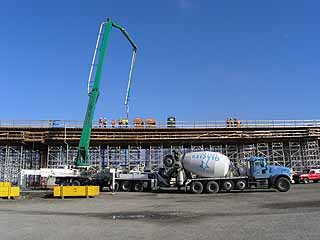
Surveys
DJC.COM
December 9, 2004
Real estate's important role in mass transit
Sound Transit

Staudinger
|
In 1996, the region's voters responded to the critical need for alternatives to sitting in gridlock by creating Sound Transit. Our marching orders: start building a mass transit system for the Central Puget Sound region.
Among the many hurdles was assembling a real estate program capable of meeting the challenge.
In the last five years, Sound Transit has poured more concrete for new transportation projects than any other agency in our region. We're closing in on completing the first wave of investments.
Our express buses, commuter trains and light-rail carry more than 34,000 riders daily in a three-county service area. The system also includes train stations, transit centers, park-and-ride lots and new direct-access freeway ramps that allow buses and carpools to move quickly between transit facilities and HOV lanes on I-5 and I-405.

Photos courtesy Sound Transit
Sound Transit is building an elevated light-rail track on property it bought in Seattle's SoDo area.
|
Sound Transit has come a long way. The Sound Transit Board established the blueprint for an integrated regional transit system and set aggressive goals and timelines for turning it into reality. The real estate program has played a significant role in making the system come together.
Where do we build?
From the start, real estate professionals rolled up their sleeves alongside the engineers and transit planners. We played a role in helping the Sound Transit Board identify the best options for delivering cost-effective transit projects in an intensely urban area surrounded by water and hills.
For years, our region had put off building the kind of mass transit investments that are critical to the mobility and quality of life in other great metropolitan areas. That procrastination came with a price: building a mass transit system would be more expensive now that explosive population and economic growth had greatly increased costs of land.
Real estate considerations were particularly key in evaluating potential routes for the Central Link light-rail system that is now under construction in Seattle. The Sound Transit Board chose an initial segment alignment that will provide a new right of way in the most densely populated area of the state. In choosing the route, the key factor was that to maximize benefits to the public, the line must go where the people are.
The real estate program began preparing for a major challenge.
A lot of transactions
|
The agency bought a city block for its Beacon Hill subway station that had several homes and businesses on it. Excavation work recently began on the station's 160-foot-deep elevator shafts.
|
Of the many Sound Transit projects that the real estate program has acquired property for, the Central Link light-rail initial segment has been the most demanding but also the most rewarding.
Central Link is really a program composed of several individual construction projects. Most of the line will be built underground and on elevated track. These grade-separated sections required some private property acquisitions, but in large part will be built on public rights of way.
In serving SoDo and the Rainier Valley, the logical choice was an at-grade alignment that will put light-rail trains in the heart of the communities they'll serve.
In all, preparing to build the initial segment required acquiring almost 750 separate property interests. While these included over 125 "full takes," many of the property interests were "partial takes" of strips abutting public rights of way. This was particularly the case in the Rainier Valley, where Sound Transit is expanding the width of the Martin Luther King Jr. Way South to build light-rail in the center.
The total also included approximately 170 temporary easements allowing use of private property during the construction process.
You need it when?
Getting there demanded a well-developed schedule that would allow sufficient time for acquisition and relocation negotiations, while still providing sufficient time for court proceedings if negotiations were unsuccessful.
Due to permitting requirements and construction sequencing plans, we needed certain parcels sooner than others. We worked with the agency's engineers to establish a property acquisition schedule prioritizing those. The schedule then drove all of our efforts, from appraisals to completions.
To meet the schedule, Sound Transit retained three principal acquisition and relocation consultants and a number of other specialists to provide services that ranged from appraisals to environmental review to translating more than a dozen languages to escrow.
As of Oct. 1, all of the required real property interests for Central Link construction were under the control of Sound Transit. Along the way there were frustrations, anxieties and temporary setbacks. But never once did we fail in securing properties before they were needed for construction.
Fair deals
Another success of the real estate effort has been that we delivered the property interests within our budget, despite rising real estate costs and the inflation that occurred during the acquisition cycle.
The original budget for the entire real estate effort was $233 million. Current projections indicate that real estate costs are expected to be about 6 percent under this budget.
We achieved this goal while maintaining a steadfast commitment to negotiating deals that provided fair market values to property owners.
Under state and federal laws, public agencies are required to go to great lengths to ensure that property owners receive fair compensation. It's noteworthy that the vast majority of our acquisitions were negotiated without involvement of the courts.
Another part of Sound Transit's commitment is working to help affected property owners and tenants to relocate. The real estate program also provided an extensive array of relocation-related compensation to affected parties. In all, Sound Transit has or will relocate 214 parties, including approximately 64 businesses. So far, 197 have been completed, with the remaining to be completed by early next year.
Looking to the future
While Sound Transit is proud of the real estate expertise we put to work building the foundations of the regional mass transit system, we cannot stop to admire our accomplishments. With these foundations in place, now is the time to plan for the next phase of regional mass transit investments.
More than 1.2 million more people are expected to live in the central Puget Sound Region over the next 20 years. There is growing recognition that we must continue working to accommodate that growth if we want to protect our regional mobility and quality of life.
Sound Transit is finalizing environmental studies looking at future population growth, housing and employment centers, and travel patterns among other growth factors.
With these studies in hand, Sound Transit will be able to work with the public in meetings throughout the region in January to begin setting priorities for how the regional mass transit system should be expanded. Some of the options may include more regional bus service, expanding light-rail and commuter rail options, and building more transit centers and HOV freeway access ramps. There will be opportunities for public involvement throughout 2005, leading to a new plan to be put before voters at a date to be determined.
As our population grows, real estate and construction prices are not getting cheaper. There will be more and more pressure in the years ahead to move forward with additional transit investments. The Sound Transit real estate program that we've built over the last four years will be there to help turn our region's transit plans into realities.
James Staudinger is Sound Transit's real property manager.
Other Stories:
- CBA's Insights program turns eight years old
- Soggy building? Better check your insurance
- Sleepy Spokane awakes to a real estate renaissance
- Let's go downtown — Bellevue, that is
- Seattle's goal: create community, not crowds
- How mixed-use can save commercial districts
- Low-income housing goes green
- Seattle's land code needs a diet
- Does your landlord have too much control?
- Alderwood gets urbanized and upscaled
- For Eastsiders, it's been the best recession ever
- Owners' reps keep a lid on project costs
- Downtown Seattle office market: Is less worth more?
- Eli Khouri
- Patrick Callahan
- Matthew J. Griffin
- Don Milliken
- Frank Stagen
- Seattle's waterfront can be an amenity for the region
Copyright ©2009 Seattle Daily Journal and DJC.COM.
Comments? Questions? Contact us.